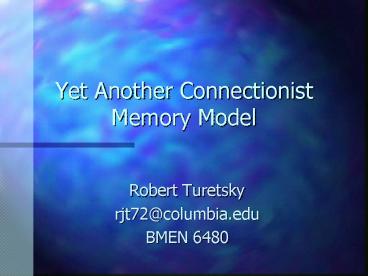Yet Another Connectionist Memory Model - PowerPoint PPT Presentation
1 / 24
Title:
Yet Another Connectionist Memory Model
Description:
Birds can fly unless they are penguins or ostriches ... can fly, unless they are penguins or ostriches, or if they happen to be dead, or ... – PowerPoint PPT presentation
Number of Views:80
Avg rating:3.0/5.0
Title: Yet Another Connectionist Memory Model
1
Yet Another Connectionist Memory Model
- Robert Turetsky
- rjt72_at_columbia.edu
- BMEN 6480
2
Memory Computational Demands
- Associative and Content addressable
- Memories are encoded, not stored veridically
- Memory is subject to distortion
- Gist Learning
- Capacity
- Noise
- Encoding and retrieval must be flexible
- Memories consolidate over time
3
The Connectionist View
- Model Simple processing units and plastic
weights between them - Memories stored in weights
- Weight training
- Interleaved
- Sequential (aka Focused)
- Structure is found by emergent similarities in
connections
4
Interleaved vs. Sequential
- Sequential
- Fast Train each vector as it arrives
- Causes catastrophic interference
- Interleaved
- Slow Must iterate through entire corpus
- Can form arbitrary relationships
- Problem Sequential learning is unstable,
interleaved learning is too slow for survival
5
Example The Exception Principle
- Birds can fly
- Birds can fly unless they are penguins or
ostriches - Birds can fly, unless they are penguins or
ostriches, or if they happen to be dead, or have
broken wings, or are confined to cages, or have
their feet stuck in cement, or have undergone
experiences so dreadful as to render them
psychologically incapable of flight
6
So how do we deal?
- At least 2 memory locations
- Hippocampus
- Short term
- Sequential Learning
- Neocortex
- Long term
- Interleaved Learning?
- Consolidation Transferring data from Hippocampus
to Neocortex
7
The Hippocampus and why we like it
8
Role of the Hippocampus
- Rapid storage of new memories
- Explicit Episodic, semantic, encyclopedic,
spatial - Not Implicit Motor skills, repetition priming
- Model salient features of tasks/episodes
- Place Cells cognitive map?
- Eichenbaums Odor Discrimination Test
9
HS High Level Architecture
- Located in Medial Temporal Lobe
- 2 parts to Hippocampal System (HS)
- Hippocampal Formation (HF)
- Entorhinal Complex (EC)
- 3 parts to HF
- Dentate Gyrus (DG)
- Ammons Horn (CA1, CA3)
- Subicular Complex
10
Hippocampus Connections
11
LTP LTD Hebb in the Head
- 2 requirements
- Presence of glutamate
- Depolarization of post-synaptic membrane
- If two afferent neurons are active at (about) the
same time, one can lead to glutamate release,
while the other will lead to depolarization.
Then the complex chain reaction with Ca leads
to LTP - Eventually committed cells emerge
12
Place Cells A Retrospective
- Place cells fire when test subject is in/near a
specific location - Distances from subjects may be encoded by phase
within theta cycle - Place fields shrink with experience in a
particular domain - Most studied feature of Hippocampus
13
Place Cells Not enough?
- With only place cells
- Reaching a goal means searching a graph
- It is difficult to find new shortcuts
- Alternative Path integration?
- Besides, there is much more to hippocampus then
place cells - Is the cognitive map treated differently or is it
just another form of semantic knowledge?
14
Towards a connectionistmodel of memory
15
Phenomenon to investigate
- Temporally graded retrograde amnesia
- No new memories, but old ones are preserved
- Time delay of up to 15 years for how long old
is - Older memories are preserved better then newer
- Cannot form new memories without excessive
repetition - Only refers to explicit memories, implicit
memories have little retrograde amnesia at all - Fundamental Questions
- Why do we need the hippocampus?
- Why does learning in neocortex take so long?
16
Memory A Connectionist Model(McClelland, 1994)
- Neocortical memory is distributed
- Recollection of a memory means activating many
different areas - Memories are content-addressable
- Ultimately, all knowledge ends up in the
neocortical system as synaptic weights - During information processing, the weights get
changed, but only slowly
17
Connectionist Model Contd
- Small changes add up over time add up
- Short episodes impact both the hippocampus and
neocortex, but in neocortex it is so minimal it
basically has no effect - Bidirectional Attractor-based reinstatement
- Hippocampus gt neocortex teacher
- This system is capable of explaining temporally
graded retrograde amnesia
18
YACMM My Memory Model
19
Memory Model Simulation
- Model hippocampus as attractor-based associative
memory (Hopfield Network) - Sequential learning
- Model neocortex as MLP network
- Backpropagation is interleaved learning
- MLP structure based on Rumelhart 1990,
connectionist update on semantic networks - Bidirectional communication
- Hippocampus trains neocortex
- Neocortex can cue hippocampus (like cache mem)
20
The Model Neocortex
- From Rumelhart 1990
21
Learning Structure
- Relationships emerge from interleaved learning
22
Catastrophic Interference
- Focused learning will allow you to remember new
facts fast, but can ruin relationships youve
already built
23
Hippocampus as Hopfield Net
24
Conclusion Together at last!
Teaches during downtime
Perceptual Input
Recalls as needed
Fast, Sequential Hippocampus (Hopfield Net)
Slow, Interleaved Neocortex (Pseudo-semantic Net)































